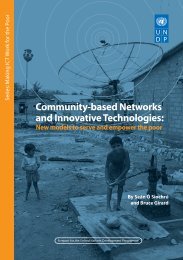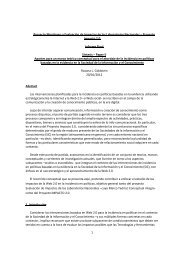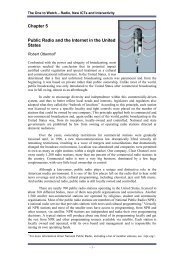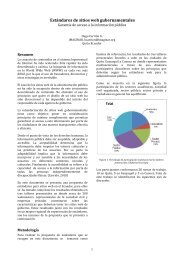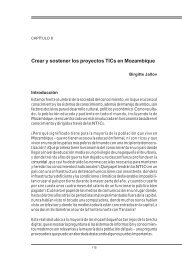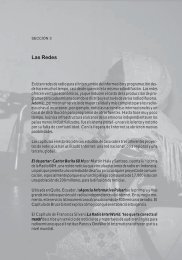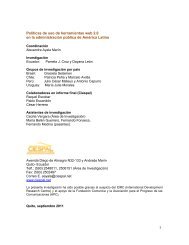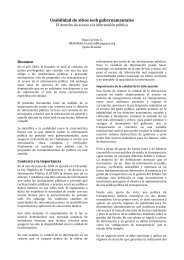report - Community-based Networks and Innovative Technologies ...
report - Community-based Networks and Innovative Technologies ...
report - Community-based Networks and Innovative Technologies ...
You also want an ePaper? Increase the reach of your titles
YUMPU automatically turns print PDFs into web optimized ePapers that Google loves.
New models to serve <strong>and</strong> empower the poor<br />
were developed in response to expressed local dem<strong>and</strong>, <strong>and</strong> that the local population<br />
participates fully in all stages of development <strong>and</strong> use. 9<br />
In Chile during the mid-1990s, the FAO’s Communication for Development group pioneered<br />
a participatory approach to the development of internet-<strong>based</strong> information <strong>and</strong><br />
communication networks among organisations of small-scale producers. The organisations<br />
were provided with data on crops, market timing, prices, market conditions, weather, etc.,<br />
as well as full access to the internet so that users could to find other information relevant<br />
to their lives <strong>and</strong> communities. However, the most important aspect of the initiative was<br />
its attention to local information needs <strong>and</strong> provision of assistance to farm organisation<br />
personnel to help them develop the skills necessary to analyse information needs <strong>and</strong><br />
disseminate locally relevant information. The methodology emerged from previous development<br />
communication experiences using small format video, print media <strong>and</strong> rural<br />
radio <strong>and</strong> it was probably the most user oriented approach to designing internet services<br />
in the developing world at the time (Ilboudo & del Castello 2003).<br />
Box 3: The Pinamar telephone cooperative (Case Study 2)<br />
From the moment it was conceived in Pinamar, Argentina in 1962, TELPIN has been considered<br />
as a community cooperative mixing strong social obligations with a business policy as efficient<br />
as a private enterprise. It is managed by a Management Council, integrated by a president, a<br />
vice-president, a secretary, an under secretary, a treasurer; five senior counsellors, <strong>and</strong> four deputy<br />
counsellors. Each member is a shareholder, but the difference between the cooperative <strong>and</strong> a<br />
corporation is that each member represents one vote, independently of his or her involvement<br />
in the cooperative or the money he or she contributes.<br />
Although all the households in Pinamar are TELPIN´s shareholders, their participation is not<br />
direct: the cooperative organises an annual general meeting at which members of the management<br />
council are elected. Except for one year, there has always been a single slate of c<strong>and</strong>idates. Whenever<br />
there is dissent, the policy is to incorporate it to the slate <strong>and</strong> to reach a consensus within the<br />
council. The members of the management council are individuals considered to be representative<br />
of the whole community.<br />
The resulting commitment to the community has been fundamental to TELPIN’s success:<br />
inspiring continuous efforts to provide managerial efficiency <strong>and</strong> better, cheaper services. The<br />
Cooperative has special payment plans for users with financial difficulties. Moreover, in months<br />
when the Cooperative’s balance is particularly plentiful, a discount is granted to all users. For<br />
a monthly payment of $10 pesos (US$3) associates receive a telephone line with unlimited local<br />
calls. In the winter months there are special discounts, <strong>and</strong> seasonal workers pay seven pesos<br />
per month, which is less than the cost of bus fare to travel in the area to search for work.<br />
In 1999 Telefónica, one of the two national telecom companies, employed twenty-eight people<br />
to call on each residence in an effort to sell its own long-distance service. By the end of<br />
two weeks, only one user had agreed to switch.<br />
These are by no means isolated examples. In May 2003 the International Institute for<br />
Communication <strong>and</strong> Development (IICD) convened a workshop to examine a broad<br />
range of experiences of ownership <strong>and</strong> partnership in ICT development projects. Discussion<br />
covered different types of ownership <strong>and</strong> how high levels of local ownership can be fostered.<br />
The workshop <strong>report</strong> concluded:<br />
24



